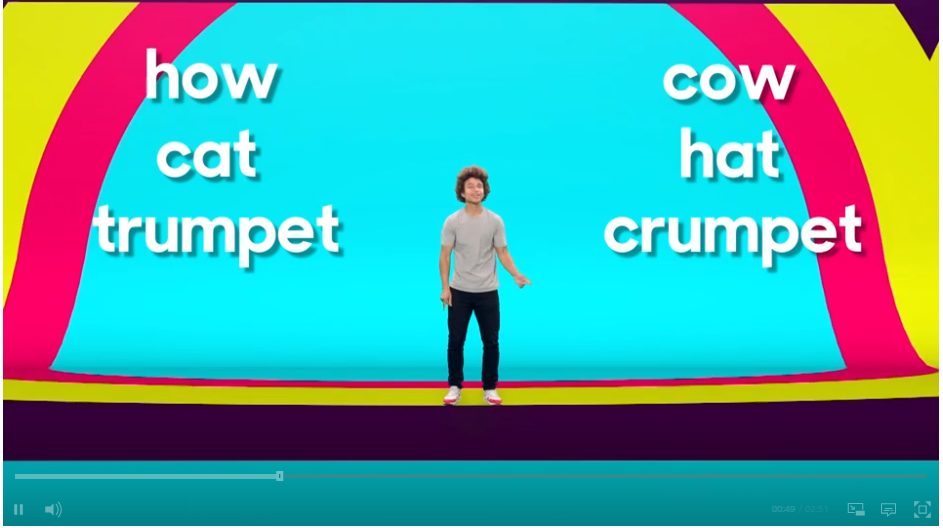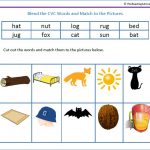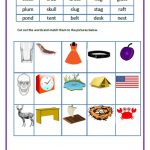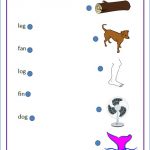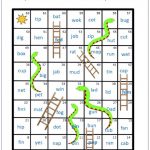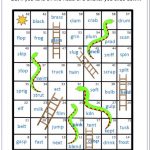A Helpful Guide for Teaching Phonological Awareness at Home or in School…
Includes free phonological awareness worksheets, activities and games online.
All of the activities we mention in this article are suitable for teaching an individual child at home, but they could also be used in a preschool/kindergarten or school classroom setting.
Some of the activities could also be used as informal assessments.
We’ve also included links to a variety of free phonological awareness worksheets and games online.
Disclaimer: We support the upkeep of this site with advertisements and affiliate links. We may earn a small commission if you click on the ads or links or make a purchase. There is no additional cost to you if you choose to do this.
Identifying Words in Sentences
It’s impossible to understand written or spoken language if we can’t identify individual words in sentences.
Some educators begin reading instruction by teaching children to count spoken words using blocks or coloured tokens. However, we don’t think this is necessary.
Children who are able to understand short sentences or phrases already know that spoken language contains words. They might not be able to articulate this, but they’ve got the basic idea.
In fact, figuring out that sentences are made up of words is one of the most basic phonological skills and most children start to grasp this idea by the time they’re around 6 months old. See our article ‘How Does Phonemic / Phonological Awareness Develop?’ for more information about this.
We want to prepare kids for reading print, so the main focus should be on helping them to identify words in written sentences.
Toddlers and young children need guidance in making the connection between sound and print. So as we read to them, it’s helpful to point to written text. It’s also worth explaining that the gaps in written sentences represent where one word ends and another word starts.
This might seem obvious to us, but words and letters just look like random squiggles to young children.
Identifying written words is easier for kids to grasp if you start with short, simple sentences. You can practice this with your child by highlighting or circling the individual words on our free ‘Identifying Words in Sentences Activity Sheet.’
Read each sentence slowly to your child as you point to each word and then show them how they can highlight or circle each word.
For example:
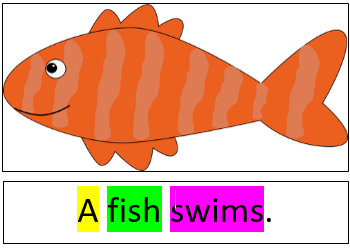
or

You could also cut out the individual words in each sentence and then reconstruct them for your child, putting each word down in front of them as you say it.
Click on the following link to download our free printable ‘Identifying Words in Sentences Activity Sheet’ as a pdf.
Rhyme Activities
Being able to recognise or produce words that rhyme can be helpful for children who are learning to read and spell.
This is because listening for rhyme gets kids to focus on the sounds in words rather than just their meaning. It also helps them to realise that words can be made up of different parts – initial sounds and word ‘endings’ that sometimes rhyme with the endings of other words.
Additionally, having an appreciation of rhyme will help children become better writers in the future, when they might want to use rhyming language in a piece of work for literary effect.
Kids can also start to recognise some of the common spelling patterns in the rhyming parts of words if they can see the words in print as well as hearing them. For example, goat, boat, coat, stoat and throat.
However, it could be potentially confusing for beginning readers to explore some rhyming words in print because a number of them have inconsistent spelling patterns; for example, gate, weight and wait, snow and go, torn and faun, bed and lead.
And a few rhyming words, such as borough and thorough, have difficult spellings.
Consequently, rhyming words like the examples above are better introduced verbally for beginning readers.
However, there are still plenty of simple rhyming words that can be printed out or constructed with magnetic letters or alphabet cards. We’ve used simple words like these in our free Rhyming Words Activity Sheet and Rhyme Sorting Activity.
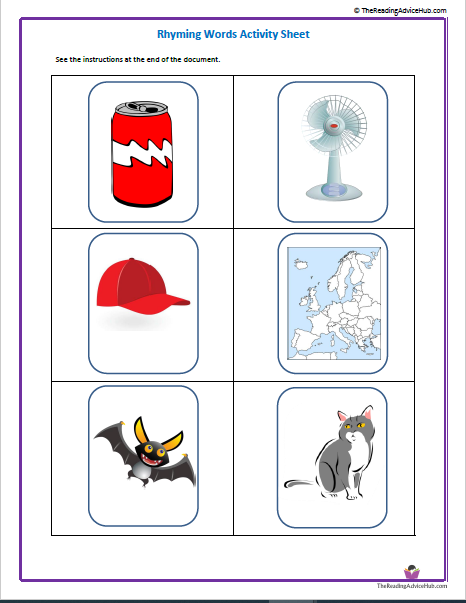 | 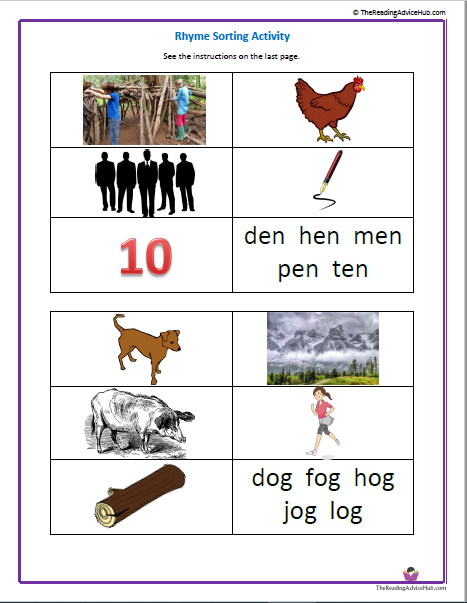 |
| We’ve also produced a set of free Odd One Out Rhyming Pictures for you to explore with your child. | 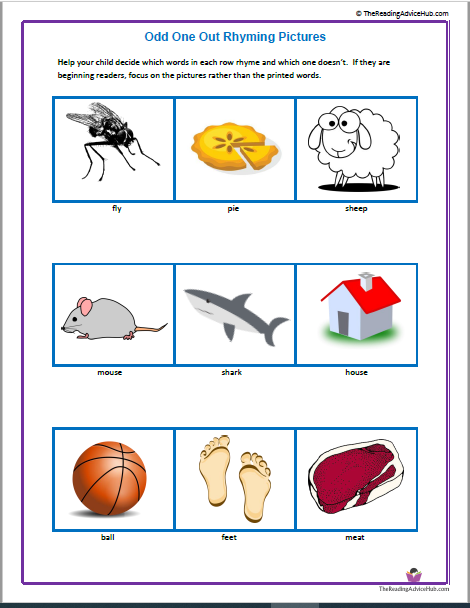 |
There are also a variety of simple activities you can do with your child that don’t require any special resources or preparation. For example, ‘I spy’.
It’s important to introduce the game when you have your child’s attention, not when they are staring at their favourite TV programme. Say something like,
“I spy something that rhymes with …..”.
Start off with simple one-syllable pairs of rhyming words. For example,
- floor – door,
- tree – knee,
- hat – mat/cat,
- gate – plate,
- cork – fork,
- head – bed,
- green – bean,
- sea – pea,
- frog – dog,
- dirt – shirt etc.
It’s harder to think of rhyming 2 syllable words that are nouns, but there are a few such as:
- handle – candle,
- (pizza) cutter – butter/shutter,
- coffee – toffee,
- socket – rocket,
- honey – money.
Alternatively, just grab some toys or point to some everyday objects around the house and see if your child can come up with a word that rhymes with them.
For instance,
“I can see a clock on the wall. Can you think of a word that rhymes with clock?”
If your child struggles, give them a clue:
“What are you wearing on your foot that rhymes with clock?”
Body Part Rhymes..
Another simple game you can play without any special preparation is to say some words that rhyme with body parts – then ask your child to guess the body part.
For example, you could say ‘soot’ and ask your child what part of their body rhymes with this. If they have trouble working it out, point to their foot to give them a clue.
Other possible rhyme combinations could be:
- farm-arm,
- whale-nail,
- beer/deer-ear,
- ship/chip-lip,
- tree-knee,
- sack/yak-back,
- dough/sow-toe,
- gum/hum-thumb (careful with this one, they might say bum!),
- bin/thin-chin,
- peck/deck-neck,
- bear/pear-hair,
- bead-head,
- honey-tummy,
- pie-eye,
- hose-toes,
- peg-leg.
You might be able to think of a few more.
Although activities like the ones we’ve described above can be beneficial, it’s not a good idea to spend too long doing them with very young children because they often lose concentration quite quickly.
So just spend a few minutes on the activities, perhaps once or twice a week. You don’t have to plan a time in advance, just look for a free moment when your child isn’t racing about.
Variety can also be important, so you might also want to let your child view the rhyming song from the BBC below or check out some of the rhyming games that can be purchased online.
The Reading Rockets website has also published a variety of rhyming activities that are free to download.
And this free downloadable phonological awareness booklet from Essex County Council in the UK has a variety of rhyming activities.
Nursery Rhymes and Rhyming Books
Songs, stories and nursery rhymes are the simplest and most enjoyable way to teach children about rhyme.
Young kids are more receptive to them than they are to structured activities.
There are plenty of nursery rhyme books and CDS available online and in libraries. And there are lots of great children’s books that use rhyme.
Our children really enjoyed Julia Donaldson’s stories plus ones by Jez Alborough such as Duck in the Truck and others.
Nursery Rhymes Online
There are also plenty of free nursery rhymes available online. For example, you can find just about every nursery rhyme ever written on the ‘All Nursery Rhymes’ website and the UK National Literacy Trust have produced a very comprehensive list of rhymes and songs for their Words for Life Site.
The Literactive site also has a good collection of animated nursery rhymes:
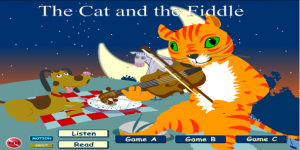 | 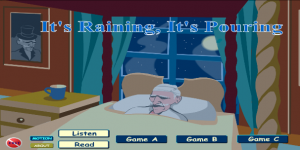 |
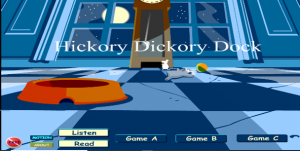 | 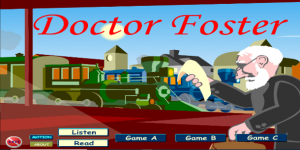 |
In addition to the ones illustrated above, they also have animated versions of:
- On Top of Spaghetti
- Mary Had a Little Lamb
- Humpty Dumpty
- One, Two, Three, Four, Five
- The North Wind
- The Grand Old Duke of York
- Baa Baa Black Sheep
- Jack and Jill
- The Kilkenny Cats
- St. Ives
- Ride a Cock Horse, and
- Six Little Mice
To access these rhymes you will need to register with the Literactive site (it’s free).
Once you’ve done that, click on the READING tab at the top then on the Nursery Rhymes 1 link, or the Nursery Rhymes 2 link in the left hand margin.
You can also access some extra nursery rhyme collections from the left hand margin.
The Starfall website also has a selection of free nursery rhymes:
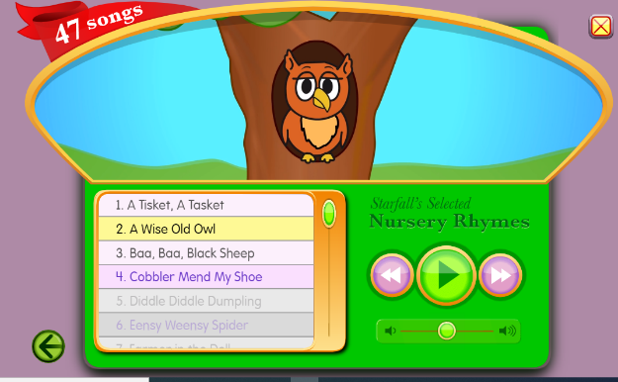
How to Get the Most Out of Nursery Rhymes
Use the following strategies to help your child grasp rhyme:
- Repetition.
- Emphasis.
- Songs and Actions.
- Ask them to recite a keyword from a rhyme.
- Ask them to spot your deliberate mistakes.
- Ask them to suggest rhyming words for rhymes you’ve adapted.
Repetition is important for learning rhyming patterns, so don’t be afraid to re-read the same rhymes to your child again and again.
If they have a favourite, by all means read it to them several times in a row if they keep asking for it. It’s quite normal for kids to fixate on things they enjoy and we want them to get as much pleasure as possible from reading books with us.
However, although children sometimes obsess about things, they can also be quite fickle, so don’t be surprised if they want you to focus on different rhymes a few days later.
Make your child more aware of rhyming words by emphasising and drawing their attention to them when you recite nursery rhymes.
For example, you can say the rhyming words slightly louder than the other words in the verse and pause for longer after each one.
Sing the rhymes to your child and do actions with them. Many popular rhymes have tunes and actions that go with them.
The BBC have a nice selection of nursery rhyme videos narrated or sung by characters from their ‘CBeebies’ programmes.
Their popular children’s character ‘Mr Tumble’ uses Makaton sign language gestures in many of his songs. This is especially useful for children with specific communication problems, but it can also help children without language difficulties.
What’s more, kids really enjoy watching and joining in with the signs. The video below contains the following songs and rhymes…
1. Miss Polly Had a Dolly, 2. The Wheels on the Bus, 3. Rock-a-bye Baby, 4. The Music Man, 5. Little Bo Peep, 6. Mary, Mary Quite Contrary, 7. I’m a Little Teapot, 8. If You’re Happy and You Know It, 9. The Grand Old Duke of York, 10. Round and Round the Garden, 11. Row, Row, Row Your Boat, 12. 1,2,3,4,5 Fish Alive, 13. I Hear Thunder, 14. I Can Sing a Rainbow, 15. Hickory Dickory Dock, 16. Incy Wincy Spider, 17. Sleeping Bunnies, 18. Hey Diddle Diddle, 19. The Sun Has Got His Hat On, 20. Chick, Chick Chicken, 21. 2 Little Dickie Birds, 22. 3 Little Ducks Went Swimming One Day, 23. Horsey, Horsey, 24. Twinkle Twinkle Little Star.
There are some extra Mr Tumble Songs on his playlist on his YouTube Channel and on this video from the BBC CBeebies website he does some of the same songs along with a few different ones:
Incy Wincy Spider, Chick, Chick Chicken, Hickory Dickory Dock, Horsey, Horsey, Round and Round the Garden, 1,2,3,4,5 Fish Alive, 3 Little Ducks Went Swimming One Day, The Sun Has Got His Hat on, 2 Little Dickie Birds, I Hear Thunder, I Can Sing a Rainbow, Hey Diddle Diddle, Twinkle Twinkle Little Star.
You can also watch some songs from the presenters of the BBC’s Baby Club on this link.
See if your child can complete a line from a nursery rhyme they are familiar with. You should only try this with rhymes they enjoy and have heard lots of times. For example, if your child likes ‘Hey diddle diddle’ you could pause at the points indicated by the lines below and ask them to recite the correct words.
Hey diddle diddle,
The Cat and the ———
The Cow jumped over the moon,
The little Dog laughed to see such sport,
And the Dish ran away with the ———.
This isn’t just about training your child’s memory; recalling the correct words will make them focus more on the patterns in the verse. This can help them grasp the idea of rhyme more quickly.
Spotting the deliberate mistake is another activity children enjoy because kids love correcting grown-ups.
Like the last activity, you should only try this with rhymes your kids have heard lots of times. Substitute a couple of incorrect words into a rhyme and see if your child can identify and correct your mistakes. For example…
Hey diddle diddle,
The Cat and the violin.
The Cow jumped over the moon,
The little Dog laughed to see such sport,
And the Dish ran away with the fork.
Altering popular rhymes and coming up with suitable rhyming words is a more challenging activity because your child can’t just rely on memory. It also requires a bit more effort from you, but it can be very enjoyable and it really lets you know if your child has grasped the idea of rhyme.
Basically, you just ask your child to suggest rhyming words for some familiar nursery rhymes you’ve adapted.
For example, if you’ve done ‘Five Little Monkeys’ with them, you could see if they can come up with the words we’ve printed in blue italics below. Pause before you say the word and ask them what they think it might be.
Five little monkeys eating in the shed,
One tripped up and dropped his bread.
Five little monkeys playing in the sand,
One fell down and hurt his hand.
Five little monkeys playing on a farm,
One fell over and broke his arm.
Five little monkeys sitting in a tree,
One fell out and hurt his knee.
If your child struggles to come up with the correct word, offer them some alternatives and ask them to choose the one that rhymes. For instance, in the last example above you could say the rhyme with 3 alternative endings…
- ‘ … and hurt his foot.’
- ‘ … and hurt his elbow.’
- ‘ … and hurt his knee.’
Free Rhyming Games Online
We’ve compiled a variety of these to save you some time searching. Click on the following link to access our collection of free online rhyming games and activities.
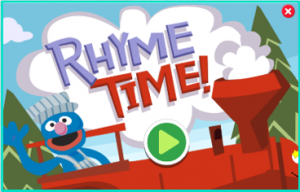 | 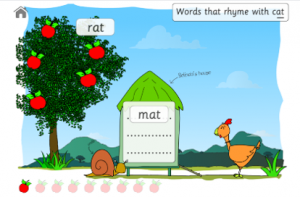 |
Syllable Activities
We think it’s easier to introduce the concept of syllables verbally to younger children before looking at syllables in written words.
This is because the letter patterns for spelling syllables don’t always match with spoken syllables in an obvious way.
How Do You Teach Children Syllables?
A simple way to describe syllables to a child is to say that syllables are the number of ‘chunks’ or ‘beats’ in a word. Tell them that some words have just one chunk or beat while others can have 2 or more.
You can demonstrate the idea in any of the following ways:
- By clapping out each of the syllables as you say a word.
- By tapping on a musical instrument such as a drum or tambourine or even a table.
- By getting the child to put the back of their hand under their chin when they say a word. Each time they feel their hand move down as they open their mouth indicates the start of a new syllable.
- By using ‘Robot Speak’ to break the word up into syllable chunks.
- By asking your child to hum words instead of saying them. Each hum represents a new syllable.
- By jumping with your child when you say each syllable.
The short videos below provide a good overview of the idea of syllables and demonstrate some of the methods to count syllables we’ve described above.
Some young kids might find this musical syllable video from the BBC entertaining and informative.
Syllable Word Lists
Although you can use almost any words to teach the concept of syllables, it can sometimes be difficult to think of suitable examples on the spot when you’re working with young children.
Things normally go more smoothly if you have list prepared in advance, so we’ve included a few suggestions for you below.
Simple One-Syllable Words
Cat, dog, fish, horse, fox, hat, door, cup, box, book, slide, watch, clock, tin, shoe, bike, boat, hand, foot, socks, toe, ear, head, mouse, desk, goat, pen, bread, pig, chair, bed, slide, pear, plum, bell, soap, grass, tree, car, bib, man, boy, book, frog, door, duck, nose, fly, house, bear, kite, star, lamp. bone, ant, bag, drum, knee, bat, leg, coat, boat.
We’ve also compiled a handy list of simple one and 2-syllable words in a pdf document that you can download and print off for free. Add any extra words that you know your child is familiar with.
Simple Two-Syllable Words
Compound words can help children develop phonological awareness because they generally find it easier to recognise 2 syllables in words where each syllable has its own meaning.
You could use some of the examples of 2-syllable compound words below. Choose words that your child is already familiar with at first.
Postman, playground, blackbird, baseball, rainbow, teacup, cupcake, snowball, toothbrush, houseboat, cardboard, cheesecake, fireplace, horseshoe, keyhole, sunrise, hotdog, football, popcorn, pancake, toenail, starfish, bathtub, bedroom, earache, backpack, daylight, eggshell, highchair, teaspoon, airplane, goldfish, birthday, peanut, earthquake.
Once your child can identify the difference between one-syllable and two-syllable words, introduce a few three-syllable words and four-syllable words. You could use the free activities we’ve put together for you below…
In our ‘How Many Syllables’ activity, you simply ask your child to tick the correct number of syllables for the object in each picture. Clap out the syllables with them if they aren’t sure. | 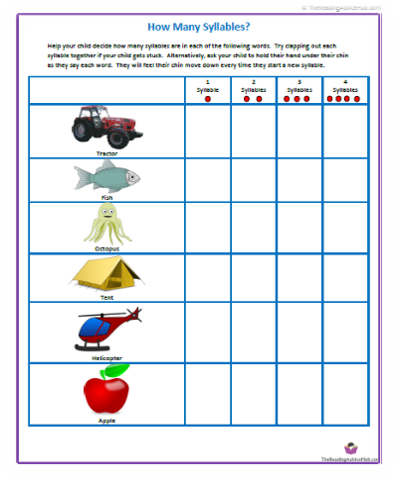 |
You could also try our ‘Sorting Words by Syllables’ Activity. Simply cut out the pictures in each category and sort them according to the number of syllables in each word. | 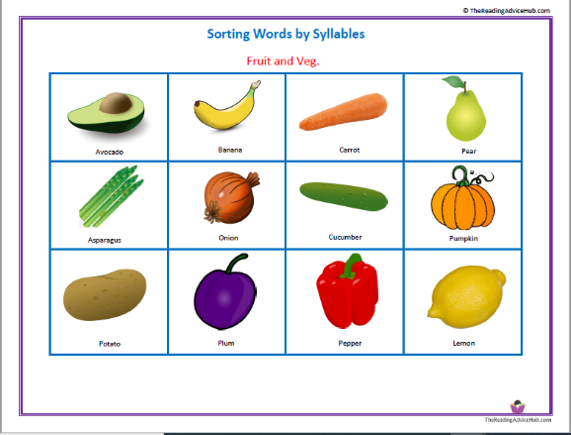 |
You can sort them underneath the printable numbers in the document or in a muffin tin or any other containers you’ve got handy.
If you want to sort some extra things, you could also use some of your child’s toys or other small objects from around the house.
Other Ideas…
The Irish Professional Development Service for Teachers have produced a phonological awareness training document and they have some interesting ideas for games that can make counting syllables more fun with a group of children.
For example, getting the children to use their two hands and to touch their heads for the first syllable, their shoulders for the second syllable, their hips for the third, knees for the fourth, toes for the fifth and heels if there is a sixth syllable!
They also suggest cutting up objects or pictures to indicate the number of syllables. Click on the link below to see more of these ideas:
Irish Professional Development Service for Teachers Phonological Awareness Training
The Reading Rockets website has published some free printable syllable activities developed by the Florida Center for Reading Research.
And this free downloadable booklet from Essex County Council in the UK has a variety of syllable activities: The Ultimate Guide to Phonological Awareness.
Free Syllable Games Online
We’ve compiled a variety of these to save you some time searching. Click on the following link to access our collection of free online syllable games and activities.
 | 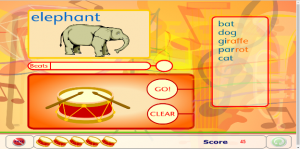 |
Phonemic Awareness Activities
Some simple phonemic awareness activities can be done on the spur of the moment without any special resources.
For example, making up spoonerisms such as ‘it’s a dot hay today’ or ‘he has a hig bat’ can be a fun way to get kids to pay more attention to the sounds in words.
You can find some examples of spoonerisms on this link, although choose carefully because they aren’t all suitable for kids.
And you can get some ideas of other kinds of entertaining word play from the late Ronnie Barker’s – Mispronunciation Sketch – although once again, some of of the examples aren’t suitable for children.
The use of alliteration is another informal way to draw the attention of kids towards the sounds in words. See our article on alliteration for more information about this and for free alliteration resources.
| Our free a-z letter sound phonemic awareness worksheets include sound matching activities that can help children develop phonemic awareness. | 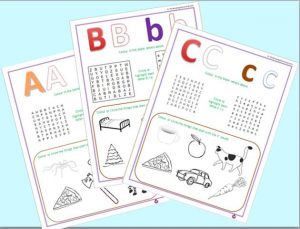 |
The Teach Your Monster to Read Site also has a fantastic range of free games that can be printed off for classroom or home use. Click on the following link to access their Tabletop Phonics games.
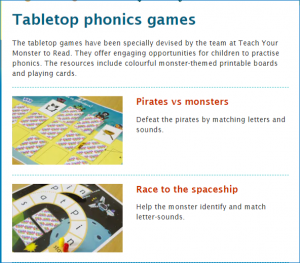 | 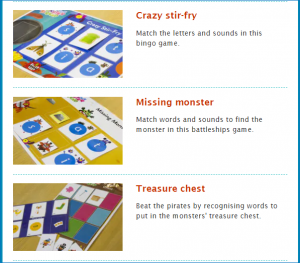 |
Free Phonemic Awareness Games Online
There are some really helpful phonemic awareness games online that can provide variety and make learning more enjoyable for children.
Click on the following link to access our compilation of free online phonemic awareness games and activities.
Teaching Letter Sounds
Contrary to the opinion of some educators, research shows that phonemic awareness instruction is more effective when it’s taught using letters.
So make sure your child knows the common sounds associated with each letter of the alphabet before you introduce them to activities like blending and segmenting. In fact, knowing letter sounds is beneficial for any kind of phonemic awareness activity.
| We explain how you can teach your child the letter sounds in our phonics article and we’ve also produced some printable letter sound and phonemic awareness worksheets that you can download for free. |  |
You might also find the following video from Little Learners helpful. It demonstrates the actions used in the Jolly Phonics programme which can help children to remember the sounds associated with the letters.
You don’t need to teach young children the letter names before they learn the sounds they represent.
Learning letter names doesn’t help much with phonemic awareness or reading instruction and it can actually have a negative effect on spelling.
We discuss this issue in more detail in our article, ‘Should I teach My Child Letter Names?’.
Free Online Games for Letter Sounds
Click on the following link or the images below to access a variety of free online games for letter sounds that can help children learn the letter sounds in a fun and engaging way.
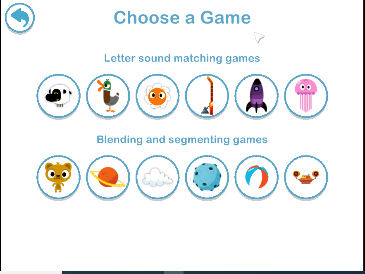 | 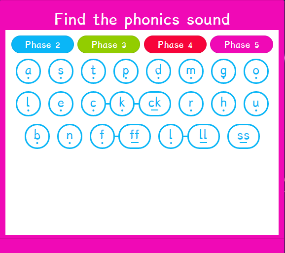 |
Once your child can identify and name the letter sounds confidently, you can move on to blending and segmenting activities.
Children generally find it easier to blend words than they do to segment them so it makes sense to start with blending…
Phonemic Awareness/Phonics Blending Activities and Games
Games and activities can sometimes be a less efficient use of time than more mundane methods of practising blending. However, the variety games provide can increase the enjoyment, engagement and motivation of some children. So, it’s certainly worth including a few games and activities once or twice a week as part of your teaching schedule.
The video below shows a very simple game where the child has to blend words and then decide if they are real or made-up words:
The game in this next video gets children to step or jump on large letters on the floor which they can then blend:
The video below from Little Learners shows some imaginative ways of using flashcards and pictures to make blending more fun and to support children who are struggling with blending. It also includes some suggestions for segmenting:
In this video, the popular Mr Thorne shows how you can rearrange letters in words to make blending more interesting. Notice how he really engages the children in the activity:
In this game, Mr Thorne uses an electronic whiteboard for a game where students have to uncover words, blend them and match pairs. The game could also be done using paper and cards to cover the words:
In this clip, the teacher uses dice and cups with letters on to make a fun blending game. The background music is a bit distracting, and we think it would have been better if the teacher had demonstrated the game using letter sounds rather than letter names. However, it’s still a useful activity that could be adapted for different types of words such as ones containing blends and digraphs:
And this short video demonstrates another way of using cups to build and blend words:
In the game below demonstrated by an ESL teacher, children have to touch the correct consonant blend on the board when the teacher says a word. The idea could be adapted for blending whole words:
The teacher in this video shows some simple ways of using counters, clothes pegs and letter cards to make blending activities more interesting:
Another game involving giant dice. We think this would be more effective without saying the letter names first:
An alternative for dice is to use 3 wooden blocks with letters written on each face. One block should contain vowel letters and the other two should have consonants.
It’s probably best if the vowel block is a different colour. The child then rolls the blocks, puts the vowel block in the middle and blends the letters to make a word.
You might also find the following video links from Little Learners useful: How to make a Phonics Flipbook | Learning to Read | Segmenting & Blending | Phonics and Phonics Wheel | Learning to Read
There are some other blending ideas you could do with a class on the Rising Stars blog.
For phonemic awareness/phonics blending worksheets, follow this link to our free phonemic awareness/phonics blending activities and games.
Use the following link to access our article on blending if you want to learn more about the best ways to teach blending. The article also includes examples of blending different types of words and tips for helping children who find blending difficult.
Free Phonemic Awareness/Phonics Blending Games and Resources Online
Click on the following link or the images below to access our free phonemic awareness blending games online page.
Phonemic Awareness/Phonics Segmenting Activities and Games
Good phonemic segmenting skills provide the foundation for successful spelling.
You can introduce your child to segmenting words after you’ve done a few short sessions of blending with them. They don’t need to have mastered blending before you do this.
In fact, practising some segmenting between blending sessions can be helpful because the two skills are intrinsically linked – segmenting is essentially like blending in reverse.
In the beginning, help your child to segment some of the simple CVC words they’ve already practised blending. Kids usually find it quite difficult to segment words at first, but they will eventually grasp the idea if you persevere.
As with blending, it’s more effective to use letters when you do segmenting activities. Magnetic letters or alphabet cards are ideal for beginners, but they can move on to writing words down after they’ve had some handwriting instruction.
We’ve produced some segmenting worksheets that can introduce your child to the process of segmenting in a more structured and gradual way.
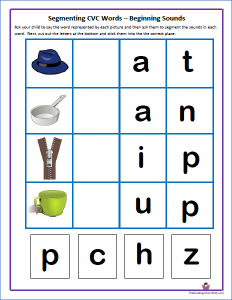 | 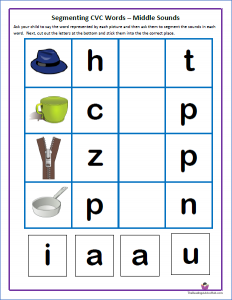 | 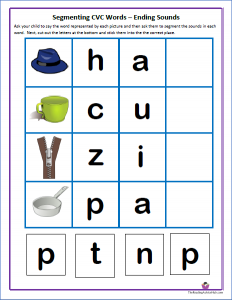 |
Repetition is really important for both segmenting and blending, so practice these skills most days if possible. However, it’s important not to do too much in one go. 5 or 10 minutes at a time might be enough for a child of preschool age and around 20-minute sessions are fine for kids doing phonics in school.
You can spend longer if you include some games and other fun activities as these are likely to make the kids more attentive and enthusiastic.
Robot talk
You can make segmenting more fun by using a model of a robot or just a picture of a robot. Choose an object and say you are going to speak like a robot as you say the name of the object. 
For example, suppose you have a toy dog or a picture of a dog. Say each sound in the word really slowly and ask your child what the sounds are – ‘d’-‘o’-‘g’. Then see if they can construct the word with magnetic letters or alphabet cards.
If they can do handwriting already then you could ask them to write the word.
After you’ve done this for 2 or 3 words, ask your child to repeat the exercise with them doing the robot talk this time. Use the same objects first and then see if they can do robot talk and figure out the spelling for some new words.
The above activity can also be done with a puppet or a toy – just call it toy talk instead of robot talk.
Free Phonemic Awareness/Phonics Segmenting Games Online
We’ve compiled a variety of these to save you some time searching. Click on the following link to access our collection of online segmenting games.
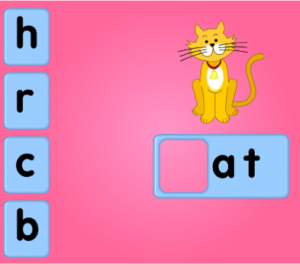 | 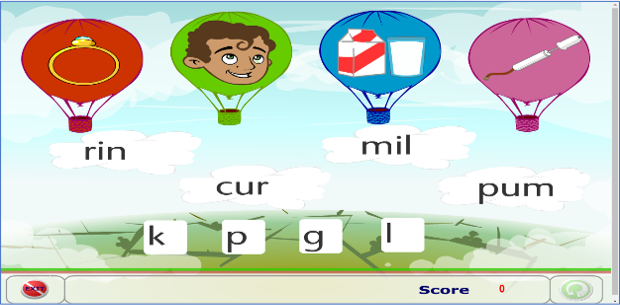 |
Phonemic Awareness Activities for Struggling Readers
All of the activities described on this page can be used with struggling readers or beginning readers of any ability. Children with reading difficulties don’t really need different types of activities – they just need a bit more guidance and support.
See our article, ‘How do you help students who struggle with phonemic awareness?‘ for information about how to do this effectively.
Further Information…
Another way to access activities for phonemic awareness and phonics is to register with some of the specialist reading programmes that offer free trials.
For example:
Parents and teachers can register for a 30-day free trial with Reading Eggs. This allows you to access over 500 highly interactive games and fun animations for developing Phonemic awareness, Phonics, Fluency, Vocabulary and Comprehension.
A 30-day free trial is also available from ABCmouse.com. This is a leading online educational website for children ages 2–8. With more than 9,000 interactive learning activities that teach reading, math, science, art, music, and more.
Although it’s not quite free, you can get a 30-day trial with the award-winning Hooked on Phonics programme for just $1.
IXL Learning cover 8000 skills in 5 subjects including phonics and reading comprehension. You can click on the following link to access a 7-day free trial if you live in the US.
If you live outside of the US you can get 20% off a month’s subscription if you click on the ad. below:
